Abstract
Two of the most significant cases of extant 16th-century featherwork from Mexico are the so-called Moctezuma’s headdress and the Ahuizotl shield. While the feathers used in these artworks exhibit lightfast colors, their assembly comprises mainly organic materials, which makes them extremely fragile. Printed media, including books, catalogs, educational materials, and fine copies, offer an accessible means for audiences to document and disseminate visual aspects of delicate cultural artifacts without risking their integrity. Nevertheless, the singular brightness and iridescent colors of feathers are difficult to communicate to the viewer in printed reproductions when traditional pigments are used. This research explores the use of effect pigments (multilayered reflective structures) and improved halftoning techniques for additive printing, with the objective of enhancing the reproduction of featherwork by capturing its changing color and improving texture representation via a screen printing process. The reproduced images of featherwork exhibit significant perceptual resemblances to the originals, primarily owing to the shared presence of structural coloration. We applied structure-aware halftoning to better represent the textural qualities of feathers without compromising the performance of effect pigments in the screen printing method. Our prints show angle-dependent color, although their gamut is reduced. The novelty of this work lies in the refinement of techniques for printing full-color images by additive printing, which can enhance the 2D representation of the appearance of culturally significant artifacts.
1. Introduction
For millennia, birds’ plumage has captivated human attention and imagination [1]. The visual appeal and cultural significance of feathers have turned them into richly expressive materials across geographic regions, including America, Asia, and Oceania [2,3]. As an artistic medium, historic featherwork comprises objects made to be worn, seen, made, or decorated with feathers [4,5,6]. Up to the early 16th century, the featherwork items produced in Mexico were ceremonial or performance objects as well as fine garments for members of the upper class [7,8]. Possibly the most representative example among the extant pieces of precolonial Mexican featherwork is a headdress made of quetzal feathers, preserved at the Weltmuseum in Vienna (Figure 1) [9].
The amanteca, the name of featherwork artists in Nahuatl, were skillful mosaic artisans who created images by manipulating minute feather barbs. In the early 16th century, feather mosaics were akin to paintings for European eyes. Their motifs ranged from animals and landscapes to human faces [10]. Instead of using paint and brushes, the color and pattern of feather mosaics were created by the precise placement and arrangement of feather barbs selected and prepared beforehand [11,12] (Figure 2 (Left)). Featherwork also had a distinct brightness and deliberate subtle tonal gradations achieved by the iridescence of the feathers, which is not attainable by conventional paints. In order to achieve the desired effect, the amanteca would position each feather “according to its appearance, as they shimmered, and glowed” [13], according to the ninth book of the Florentine codex (9:96) [14], a 16th-century encyclopedia on Nahua culture, wherein the techniques on precolonial featherwork are reported.
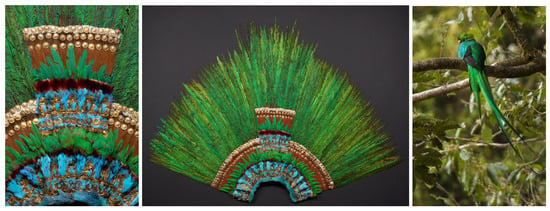

Figure 1.
(Left) Detail of headdress made of feathers from quetzal and cotinga birds. (Middle) Full view of headdress made of feathers © KHM-Museumsverband, Welt-museum Vienna. (Right) Resplendent Quetzal. Image retrieved from Wikimedia Commons, licensed under the terms of the CC-BY-2.0 [15].
During the colonial period, between the 16th and 19th centuries, featherwork became relevant and influential worldwide, although its focus shifted to Christian icons and liturgical vestments [10,16]. The Salvator Mundi and the Ecce Agnus Dei in Figure 2 are outstanding testimonies of New Spain’s feather art [12]. Most of these artworks were sent to overseas collections and were deeply appreciated in Europe and Asia [17]. Through feather mosaics, indigenous artists reinterpreted the European aesthetics of oil painting, appropriating the brilliance of medieval imagery [18] and introducing novel color-shifting images to European audiences [19].
In Mesoamerican cultures, such as Nahua, Mayan, and Mixtec, iridescent feathers, jade, turquoise, gold, and nacre shells were valued as precious materials because of the intense sensory experience they provoked [20]. These materials have a strong response to light, which results in vibrant colors, sheen, and often iridescence. Among the Nahua people, the appearance of precious objects, such as the iridescence of featherwork, communicates the essence of tonalli, the animacy or vitality derived from the sun and bestowed upon beings at birth [18].
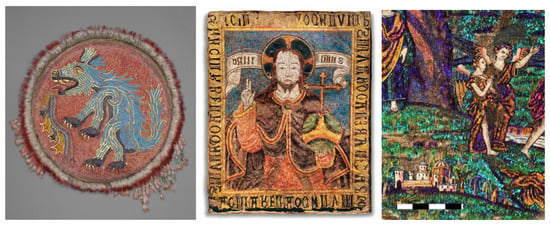

Figure 2.
(Left) Ceremonial shield, early 16th century, 70 cm diameter, VO 43380 © KHM-Museumsverband, Weltmuseum Vienna. (Center) Salvador Mundi, 16th century, at INAH-National Museum of the Viceroyalty. Image used under CC BY-NC 4.0 DEED [21]. (Right) Detail of Ecce Agnus Dei, 16th–17th century. Musée du quai Branly–Jacques Chirac, Paris, 70.2019.35.1 ©Coutau-Bégarie Auction House [22].
1.1. The Reproduction of Structural Colors Using Effect Pigments
Due to being intrinsically conceived as 3D, light-responsive [13], and dynamic [23], featherwork is difficult to reproduce in bi-dimensional formats. The color of feathers is accompanied by a high degree of shine and changes with the observation and illumination angle [24] due to the presence of structural coloration [25,26], which renders a visual sensation not attainable when looking at painted or printed images [27].
In the context of printing, non-absorbing coloration based on so-called Spectraval effect pigments is a recently developed alternative to color mixing based on absorbing cyan, magenta, and yellow primary inks [28]. Effect pigments are synthetic microscopic structures, usually iridescent flakes, that produce color by selective reflection and interference [29,30]. These structural materials exhibit optical qualities analogous to nature’s iridescent multilayer reflectors, such as those found in beetles, enabling artists and scientists to approach color reproduction on a physical level [31]. A systematic analysis of the mechanisms that cause iridescent effects in animals conducted by Schenk and Parker [32] proved the possibility of matching the appearance of Morpho butterflies, beetles, and cuttlefish by painting with structural colorants, as well as the hybrid coloration of green feathers from the Senegal parrot.
1.2. Aim of the Research
When selective reflectors are used in printing, many assumptions based on traditional inks no longer apply, such as the subtractive mixing model. This work responds to the need to adapt printing applications to the physical and perceptual behavior of selective reflectors and their combinations. The aim is to contribute to the development of printing methods for reproducing the appearance of cultural heritage items, arguing that printing technology is a valuable tool in the dissemination of knowledge through books, catalogs, educational materials, and fine prints. As emphasized, the perceptual properties of featherwork are essential to the meanings of the artworks; therefore, it is important to communicate them in a printed reproduction.
We use Spectraval effect pigments to create prints that convey the color, texture, and luminosity of featherwork while developing an alternative to subtractive mixing in image reproduction. We have explored the process of reproducing two digital images of featherwork via screen printing using red, green, and blue (RGB) selective reflectors as additive primaries on black paper to find adequate printing parameters, such as mesh size and halftone resolution. We have applied different halftoning techniques and verified that the recently proposed structure-aware halftoning algorithm [33] improves the performance of RGB inks in representing the fine surface details of feathers in a three-color screen print, presenting the initial results in [34]. In this work, we produced printed images of the Ahuizotl shield and conducted a qualitative analysis of its visual qualities. Furthermore, to contrast this process with regular subtractive printing, we measured the reflectance of patches with different coverage and their combinations, as well as their density.
As an original contribution, this research proposes the enhancement of the traditional 2D reproduction of images originally colored with feathers by additive color printing, demonstrating angle-dependent color in printed surfaces. Moreover, this article suggests shifting the focus on featherwork from art history to color science. We emphasize the technical achievement involved in the ancient craft of producing images via featherwork techniques, which implies the combination of structural color and absorbing pigments—a task that remains highly challenging today when new materials are employed.
2. Structural Colorants: From Nature to Prints
The Color of Feathers
In the Mesoamerican region, feathers were obtained from wild and domesticated birds, including the scarlet macaw, roseate spoonbill, lovely cotinga, montezuma oropendula, squirrel cuckoo, white-fronted parrot, and altamira oriole, and local birds such as the great-tailed grackle, harpy eagle, golden eagle, hummingbird, and heron [8]. These feathers provided a broad palette of green, blue, black, yellow, red, white, rose, and violet. The most appreciated colors were iridescent, bright, and lively or with sober shades [12].
The various colors of feathers depend on how the light interacts with the pigments and semi-transparent structures that constitute a feather barb, (as illustrated in Figure 3). Structural color in feathers is produced when the light is broken down by the microscopic-layered structures of alternating keratin and melanin. A spongy structure of air cells regularly distributed in a keratin structure can also cause the interference of reflected short wavelengths, producing blue and violet hues [35]. When it comes to pigments, melanin is responsible for brown and black colors, while carotenoids are responsible for yellow, orange, and red [36].
Both absorbing pigments and ordered tissue always influence the color of feathers. From a physical standpoint, pigments produce light-selective absorption, whereas structures induce the selective scattering of light. The structural colors of feathers exist on a continuum, ranging from incoherent scattering by random structures to coherent scattering by small-scale ordered structures that result in interference colors [37,38,39,40,41]. Table 1 shows the predominant color-producing mechanisms of feathers identified in Mexican featherwork.
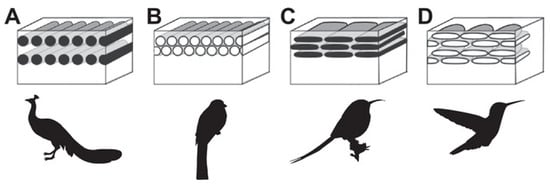


Figure 3.
Schematic drawings of cross-sectioned barbules, showing the main types of melanosome morphologies found in iridescent feathers. Silhouettes represent examples of bird families with the illustrated morphology. (A) Solid cylindrical melanosomes, (B) hollow cylindrical melanosomes, (C) flat and solid melanosomes, (D) flat and hollow melanosomes. Silhouettes: (A) Phasanidae, (B) Trogonidae, (C) Nectariniidae (sunbirds), and (D) Trochilidae (hummingbirds). Image credit for silhouettes: Natasha Sinegina (A) and Katerina Ryabtseva (D), downloaded from [42] under the Creative Commons license.

Table 1.
Color-producing mechanisms of feathers found in featherwork [37,43].
Table 1.
Color-producing mechanisms of feathers found in featherwork [37,43].
| Color | Producing System | Species | Perceived | Artefact |
|---|---|---|---|---|
| Pigment-based | Carotenoids | Roseate Spoonbill | Red-Pink | Feather shield |
| Melanin | Golden Eagle | Brown | Feather shield | |
| Iridescent | Structural color | Hummingbird | Various | Pendant triptych |
| Resplendent Quetzal | Green-blue | Headdress | ||
| Non-iridescent | Structural color | Cotinga | Blue | Feather shield |
3. Spectraval Effect ‘Pigments’
Synthetic structural colorants, such as the so-called effect pigments, produce color through light interference or selective reflectance and transmission and consist either of substrate-free particles or layered structures. These materials are not pigments according to the term’s formal definition: non-dissolved particulate solids that alter their appearance by selective absorption and/or by the scattering of light [44]. However, building upon the existing literature, we use the term effect pigment with an awareness of the distinction between absorbing and non-absorbing particles. In the last decades, there have been diverse developments, especially for the substrate-based types, e.g., multilayers of mica or pigments based on alumina, silica, and glass flakes [45]. A surface coated with effect pigments typically shows a metallic sheen, and it can look dramatically different with different directions of illumination and observation [46].
The Spectraval™ pearlescent colorants developed by Merck consist of mica and titanium dioxide layers that reflect specific narrow bands associated with the primary colors red (R), green (G), and blue (B) [47]. At the microscale, as shown in Figure 4, Spectraval™ reflective flakes appear translucent and have iridescent properties.
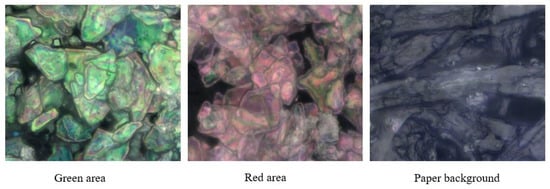
Figure 4.
Magnification of Merck’s Spectraval™ green and red pigments, and Plike black background paper. These are white light true-color images with all display settings in the central position of a X100 lens. The approximate area of the image is microns.
When the ink is applied by printing, the color fades when looking at it from an oblique angle. This means that the hue of a layer of red, green, or blue ink usually appears grayish when looking at it from an oblique angle, and it changes to either red, green, or blue, accordingly, as the viewer approaches a more perpendicular observation.
In addition to the thickness and type of metal oxide, the color produced by pearlescent pigments is determined by the platelet size, particle size distribution, platelet orientation, pigment concentration, film transparency [48], and application method. The misalignment of individual pigment particles and the thickness of the printed layer that allows placing multiple particles underneath each other provoke reflections of multiple wavelengths in multiple directions and can produce incoherent scattering. Inks made with effect pigments are not suitable for inkjet printing due to a large pigment size (up to 25 microns) but can be employed in screen printing, flexo printing, and even direct lithography [49]. In order to maximize the generated color of the pigments, it is better for the particles to lay flat on the surface, which can be best achieved by screen printing.
Although thin-film interference yields strong saturated colors, those inks prepared with effect pigments and a binding medium result in faded colors when printed. Color fading with illumination direction that approaches oblique angles can be observed from the reflectance values of individual primary inks at dominant wavelengths (650 nm: red, 550 nm: green, and 450 nm: blue), as shown in Figure 5.
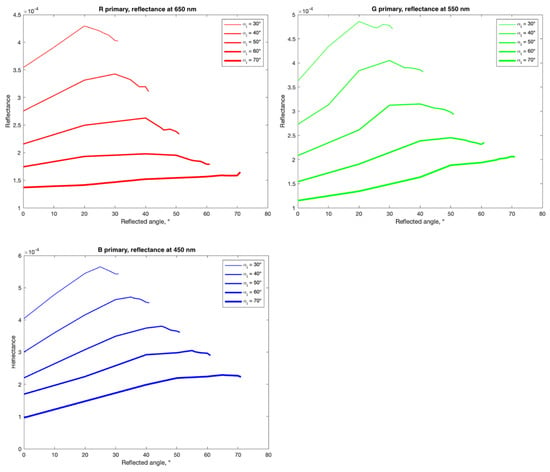
Figure 5.
Reflectance of each primary ink at characteristic wavelengths for different illumination and observation directions. These measurements were taken by a system consisting of a goniometer, a xenon lamp with a focusing lens, and a spectrometer, as in [50].
Maximum reflectance for specular directions corresponds to thin-film reflectance, whereas the nonzero values for other directions of reflectance are due to the roughness of the printed layer and pigment particle placement inside the ink, which increase the scattering of white light while reducing the intensity of the dominant wavelength.
In this sense, color and appearance reproduction using special pigment inks is a matter of careful consideration in terms of the primaries’ bi-directional reflectance distribution function (BRDF) rather than the individual color co-ordinates of traditional pigments. Although techniques for printing 2.5D and 3D using the mentioned pigments have not been presented to our knowledge, their angular-dependent reflectance properties can be employed to replicate those of natural structures. When it comes to screen printing with Spectraval™ pigments, the recommended concentration of pigments is not only guided by the optimal appearance but also by the viscosity requirement of the mixture. When using the traditional screen printing procedure, the maximum concentration is pigments in the mixture.
Another limitation of full-colour reproduction comes from the halftoning techniques commonly used in screen printing. Overlapping halftoned dots lead to color fading due to the combination of interference and transmission at thelevel of individual pigment particles [50]. Avoiding dot overlapping can improve the saturation of the colors, although this would require very precise alignment. In large formats, the paper often suffers distortion due to the wetness and weight of the inks.
Additive Color Mixing
According to the subtractive CMYK color model, which is based on light selective absorption, superimposing the primary inks—cyan, magenta, yellow, and black—in various proportions creates a wider array of colors. Red, green, and blue effect inks reflect the light; therefore, they have been developed as an additive color system, which predicts color mixtures by adding the numeric values of coincident component lights [51].
The RGB model is used to characterize the colors produced by the emission or reflection of light [52]. Common devices and applications use monitors, where light is emitted from a dark screen, or projection systems, where light is reflected from a white screen. In RGB additive printing [53], reflective inks are applied on a black substrate that absorbs any transmitted light, which is in contrast to CMYK process inks, whereby overlaying red, green, and blue effect inks results in white, as most of the light of all wavelengths is reflected. Printing an image using reflective inks will involve printing the highlights instead of the shadows. Nevertheless, the printed colors produced by effect inks have a metallic sheen to them and change with the angles of viewing and illumination. For instance, the result of printing green + red is a golden yellow.
4. Materials and Printing Methods
4.1. Descripton of Images: Featherwork at the Weltmuseum
The 16th-century headdress shown in Figure 1 is made with over 450 feathers from the tail of the resplendent quetzal (Pharomachrus mocinno) and the plumage of the squirrel cuckoo (Piaya cayana mexicana), pink roseate spoonbill (Platalea ajaja), and blue lovely cotinga (Cotinga amabilis). It is 116 cm high and 175 cm across and has the form of concentric layers of different feathers mounted on a net of vegetal fibers and wooden sticks arranged in a semicircle [54]. The front part is decorated with gold ornaments. In its original state, a golden bird’s beak was attached to it. The feather headdress was rediscovered in 1876 by Ferdinand von Hochstetter in the personal collection of Archduke Ferdinand II of Tyrol (1529–1595) known as the Ambras Collection, which he assembled first in Prague, then in Innsbruck, and finally at the castle of Ambras. Upon its discovery, the headdress was restored, and feathers and metal ornaments were substituted [55].
Another feather item found in the Ambras Collection was a ceremonial shield adorned with a feather mosaic depicting a blue mythic animal Ahuizotl (“spiny water dog” [56]) on a red background, with gold leaf decoration. Emerging from the mouth of the coyote is the Aztec glyph -, representing burning water [57]. The shield has a framework of reed splints, wood, and leather, covered with agave paper, to which the mosaic is glued. The feathers came from various birds, including the blue cotinga, scarlet ara (Ara macao), yellow oriole (Icterus nigrogularis), and pink roseate spoonbill [7]. The mosaic consists of feathers glued to mate paper that is cut to shape, which is then attached to the base in a shingled manner [58]. Feathers are also attached to the edge of the shield, with several tassels of feathers hanging from the lower edge. The shield has a diameter of 70 cm.
4.2. Inks Preparation
The Spectraval™ red, green, and blue pigments used for this study are titanium dioxide-coated mica plates, with an average diameter ranging from 5 to 25 m for red and green and from 1 to 20 m for blue, as stated by the supplier.
Daler Rowney’s System 3 was used as the printing medium. The powder pigments and medium were combined based on weight. Three inks were prepared, each one with the following proportions: 9% red, 12% green, and 15% blue powder pigments, respectively. These percentages were recommended by the supplier. Effect inks appear nearly white in a powder form; however, they exhibit color when applied to a black substrate. A light layer of ink reflects a specific portion of the light spectrum while transmitting the remaining wavelengths to the substrate.
4.3. Halftoning
The reprographic technique of halftoning creates the illusion of a continuous tone by a combination of halftone dots, varying either in size or spacing. Halftoning algorithms convert a continuous-tone image into a binary image suitable for digital printing. By utilizing a limited number of inks, halftoning also enables a diverse range of shades and colors [59]. Given the innovative nature of the Spectraval™ pigments and their specific, rather reduced color gamut, halftoning algorithms can signify an improvement in image quality.
When printing an image in color using three primary colors (such as red, green, and blue), the image is decomposed into separate primary color channels or monochrome images. Each color channel is halftoned independently, resulting in separate sets of dots for each color. The final color image is obtained by superimposing all the monochrome set of dots. In the printed image, each array of dots is rotated (usually by 0°, 15°, 45°, and 75° for yellow, cyan, black, and magenta, respectively [60]) from the preceding one to avoid the creation of large scale, symmetrical clustering of the dots, called a pattern, which would result if two of the sets of dots being almost but not exactly aligned [61]. Here, separate screens are made for the red (R), green (G), and blue (B) inks.
A particular halftone structure determines the spatial distribution of the dots, hence the spatial distribution of pigments on a print. Different halftone structures generate different spatial configurations of the inks’ deposition, leading to changes in the print’s appearance.
4.4. Halftoning Algorithms
By controlling the size, density, and arrangement of halftone dots or patterns, it is possible to influence the range of tones and gradients in a color print. Halftoning algorithms enable the control of these parameters. For example, in first-order frequency-modulated (FM) halftones, individual dots are distributed in a stochastic manner, where the dot size remains constant, but their density varies. In second-order FM (also known as stochastic clustered-dot halftone), both the size and the spacing between dots are variable.
In the first-order frequency-modulated halftoning algorithm, single dots are placed in isolation. The size of the dots is fixed, and their spacing varies. Thus, to generate a light tone, the dots are dispersed sparsely, whereas they are distributed more densely to create a darker tone. In the second-order frequency-modulated halftoning algorithm, dots form clusters, and both the size and spacing between them are variables of the target tone. It means that, to reproduce a light tone, small clusters with larger space between them are generated; however, to reproduce a darker tone, clusters grow in size and become densely distributed.
We have studied the performance of different halftoning algorithms in creating the appearance of the feathers via screen printing, presenting preliminary results in [34]. We used the first- and second-order frequency-modulated halftoning algorithms proposed in [62] and the structure-aware color halftoning proposed in [33] to create halftones for screen printing.
In the structure-aware halftoning algorithm, the halftone dots are distributed in line with the high-frequency details of the image. This algorithm uses the angle of the dominant line in each pixel’s neighborhood as supplementary information to align the halftone structures with the dominant orientation in each region. As a result, the printed picture is sharper and gives a more three-dimensional impression compared to the prints with the nonstructure-aware halftoning algorithm [33].
4.5. The Screen Printing Process
Screen printing is a stencil process utilizing a fine mesh stretched over a frame. In contemporary screen printing, the so-called screen consists of a frame covered with a mesh made of nylon or polyester. The initial step consists in applying a photosensitive emulsion onto the screen. Once the emulsion is dry, the coated screen is exposed to UV radiation using stencils, transparent photographic images, or drawings on transparent film. Subsequently, the screen is washed to remove the non-exposed parts of the image, followed by drying. In order to apply the ink, the screen is positioned onto the substrate, and a flood bar or squeegee is used to force the ink through the screen (Figure 6). Due to the flexibility of the screen and the minimal pressure required for ink application, screen printing can be performed on various substrates, including fabric, glass, metal, wood, and paper. Screen printing is versatile and can be utilized on surfaces that are not necessarily flat [63,64]. In this work, however, we require the substrate to be as flat and smooth as possible. We have made prints on Plike®, a type of soft-touch paper [65], and glass.

Figure 6.
Screen printing process. From left to right: ink preparation, the application of ink on the screen, and applying pressure with a squeegee.
At the start, the color of the target images is digitally inverted and then separated into red, green, and blue channels. Each color separation is halftoned independently, printed on transparent film using a large format ink-jet printer, and finally transferred onto a photosensitized screen through UV exposure.
In our studio, prior to exposure, the screens are degreased with Pregasol, dried at 30 °C for about 15 min, and coated with photosensitive emulsion Azacol Z1. Once the emulsion is dry on the screens, a halftone pattern of each color channel is transferred onto each screen. This is carried out by exposing the screen to UV light covered by the transparent film containing image information, which, in this case, is halftones. We have used an exposure time of 27 s for all screens. We used a vacuum UV exposure unit that uses LED tubes with a 395 nm wavelength. After exposure, the unexposed emulsion is washed off with water to reveal the stencil in the mesh. For printing, we used a 43× 64 printing bed with a vacuum (Figure 6).
5. Experimental Section
When printing an image using RGB effect inks using screen printing, it is important to ensure that the pigment size, mesh size, and halftone resolution will be compatible to preserve image information. This can be carried out by printing wedges or steps of increasing opacity. Measuring the density of printed inks provides information on dot gain to help printers correct the image files prior to the printing process. Furthermore, analyzing the reflectance of combined layers of ink helps better understand the qualities of RGB inks and the images printed with them, beyond photographic recording and color measurements.
5.1. RGB Halftoning for Screen Printing
Test images were produced using different halftone structures, such as first-order, second-order, and structure-aware FM halftones, which are employed at resolutions of 100 dpi and 150 dpi.
We generated wedges of increasing intensity, to which symmetrical and “aligned” first-order halftoning was applied. Test wedges with varying ink coverage percentages were printed in red, green, and blue. Figure 7 shows examples of test wedges halftoned at 100 dpi and 150 dpi and with different structures. These examples show first-order halftoning with a 30° alignment and symmetrical first-order frequency-modulated (FM) halftoning.
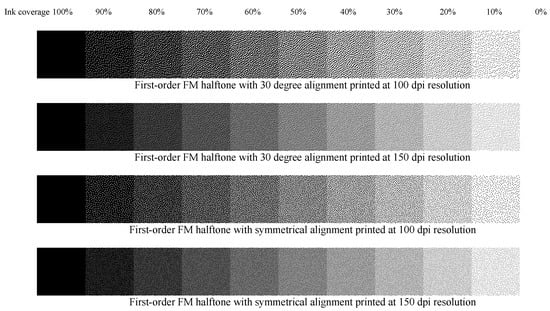
Figure 7.
Test wedges halftoned at 100 dpi and 150 dpi with first-order halftoning, with a 30° alignment and symmetrical, first-order frequency-modulated (FM) halftoning.
5.2. Measurements Device
The reflectance spectra and color co-ordinates were measured using a colorimeter X-Rite i1Profiler. The device uses LED illumination (including UV), and it has an aperture that is 4.5 mm (0.18) in diameter and an illumination spot size of 3 mm (0.12). The color measurements were taken in the M1 mode for an observer at 2 degrees under a D50 spectral distribution. Reflectance intensity values are measured in intervals of 10 nm in the range of 380–730 nm. Color co-ordinates are given by the CIE (1976) and XYZ color systems.
6. Results
The reflectance spectra and the color co-ordinates of these inks applied by screen printing on black paper, shown in Figure 8, exemplify the optical response and visual qualities of our RGB inks. The reflectance curves, as well as the color co-ordinates, were measured using an X-Rite colorimeter. The dots in Figure 8 (middle) show that the a*, b* co-ordinates of the red, green, and blue inks are clustered around the white point in the CIEL*a*b space. By screen printing the RGB chart of 400 patches created through i1Pro software, we can estimate the gamut achievable with these inks and methods. In general, effect pigments have a much smaller gamut than sRGB standard color spaces for computer systems and the internet, such as sRGB [66] or Adobe RGB (1998) [67], and, as previously mentioned, are considered to not be suitable for realistic color prints.

Figure 8.
Reflectance spectra (left), color co-ordinates (middle), and gamut (right) of red, green, and blue Spectraval™ inks, each one consisting of a concentration of 9, 12, and 15% powder pigments in an acrylic binder, respectively.
6.1. Color Mixing
Test charts are an important tool for printer calibration and color profiling. We have printed a test chart of 918 colors that was generated using the i1Pro software (v3.3.0). We measured the reflectance spectra of screen-printed patches with different color proportions using the X-Rite i1Pro color meter. Figure 9 shows the spectra of some representative examples, including cyan, magenta, and yellow. The color of each curve matches the input RGB values of the patch. Reflectance data can provide information that is useful for comparing the original and the copy when the first is available.
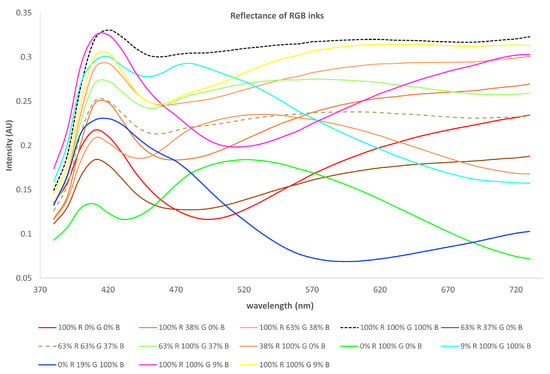
Figure 9.
Reflectance of patches printed with layers of red, green, and blue ink applied at different coverage percentages.
6.2. Effect of Halftoning on Image Appearance
Screen printing has a limitation on image resolution, determined by the size of mesh apertures, which should be at least three times larger than the particle size. The size of the pigment particles ranges from 1 to 25 microns; therefore, having a mesh with holes less than two times bigger than the pigments can affect the flow of the pigments through the mesh. Initially, we used screens with a high mesh count of 90 threads per cm (308 threads per inch) and 120 threads per cm (308 threads per inch). We found that the prints made using a 90T mesh displayed a more natural appearance of feathers when using the structure-aware halftone. The structure-aware halftoning algorithm aligns the distribution of dots (pigments) with the image content, which results in a printed image that better preserves the texture and structural characteristics seen in the digital version. Our observations confirmed that the algorithm enhanced the sharpness and details of the input image, improving the representation of the image structures, such as those found in the feathers of the headdress. The cropped sections of prints produced with second-order and structure-aware halftones are illustrated in Figure 10.
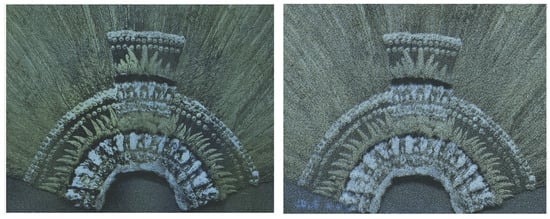
Figure 10.
Sections (250 mm × 180 mm) of the prints produced with second-order (right) and structure-aware halftone (left) using a 90 T mesh.
Figure 11 shows a print made using a 120 T mesh and the structure-aware halftoning algorithm. Using a 120T mesh count in comparison to 90T potentially enhances the reproduction of the fine detail or high-frequency features of the images, (as shown in Figure 12). The image of the Ahuizotl shield was printed only with a 120T mesh and using structure-aware halftoning at the resolution of 100 dpi.
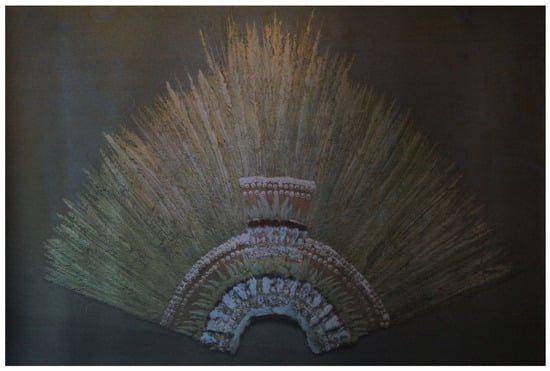
Figure 11.
Print of the headdress, made using a 120 T mesh and the structure-aware halftoning algorithm. Dimensions: 878.5 mm × 675 mm.
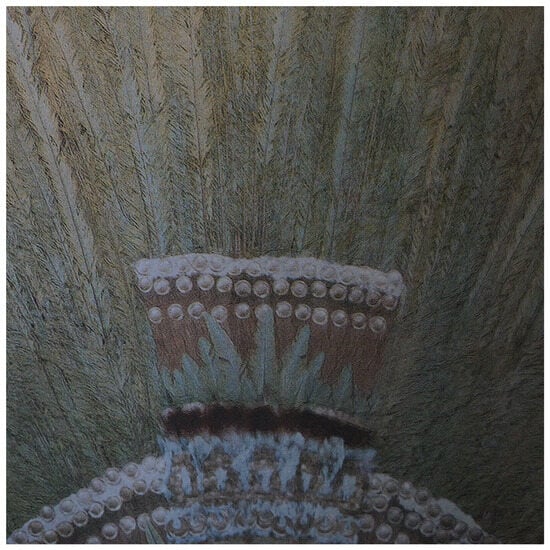
Figure 12.
Detail of the print of the headdress. Spectraval™ inks on paper.
6.3. Reflective Tints: Printing the Highlights
In traditional printing, tints represent the relative amounts of solid opaque ink on a white substrate. The densities [68] of a scale of tints are limited by the reflecting power of the paper itself at the highlight end and the density of solid black ink at the shadow end [69]. This means that the substrate (white paper or transparent film) has the lowest density, and as the tint increases, the covered area and the density increase.
On the other hand, in the test scales printed with reflective pigments on a black substrate, as in Figure 13, the reflection density is lowest for solid ink ends and highest for the substrate. In general, the density is higher when the area covered with ink is smaller. This effect can be seen in Figure 14. Effect pigments reflect more light as they spread out, leading to a lower density value in the tinted areas than solid ink. This behavior is the inverse to that measured in the film printed using black, which is used to make the screens.

Figure 13.
Tint wedges printed with red, green, and blue inks, based on Figure 7.
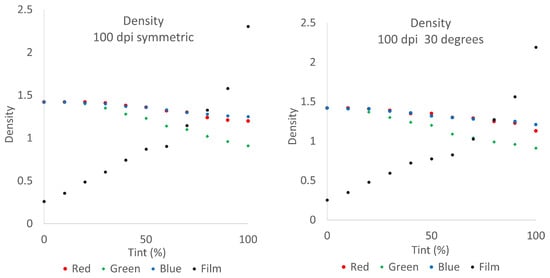
Figure 14.
Density of halftoned tint wedges between 0% and 100% coverage using steps of 10%, printed using black ink in film and printed using red, green, and blue inks on black paper. The density values measured from the wedges shown in Figure 13 and the values in film.
When printing with black ink, the shadows of an image are printed. In this case, halftone screens cannot yield denser shadows than the density of the ink used for printing or lighter whites than the paper stock used. In contrast, when printing with RGB inks on black, where, as can be seen, the dark substrate has a higher density than the tinted areas and solid ink, the halftones will subtract shadows from the paper; therefore, this will print highlights. This is the reason why the images are inverted in the preprint stage.
6.4. Prints of the Ahuizotl Shield
After experimenting with halftone structures, we made a final print of the ceremonial shield for display. At the start, the original image is inverted in RGB space and separated into red, green, and blue color channels. Then, the grayscale information channel is turned into a binary image by the structure-aware halftoning algorithm at 100 dpi. The resulting binary files are printed in transparencies by inkjet and then used for the screen’s exposure, according to the procedure described above. The screens used have a 120T mesh. Figure 15 shows the successive application of layers onto paper. A regular version of the print, and a print made with double the amount of red ink (two pulls) can be compared in Figure 16. Figure 17, on the other hand, shows the comparison of a fragment of the original photo and a screen print where the pattern created by structure-aware halftoning is noticeable.
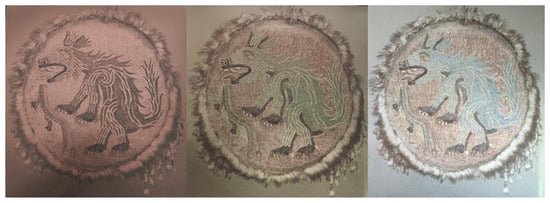
Figure 15.
The three stages of the printing process. The successive application of layers of red, green, and blue ink.
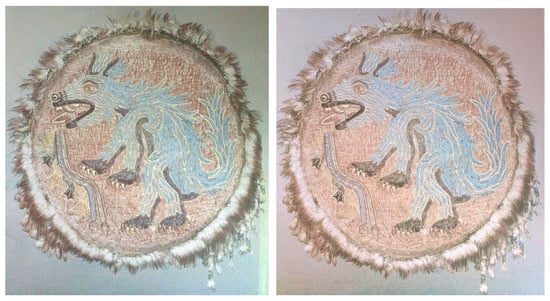
Figure 16.
Two variations of the print. The version on the right has double the amount of red ink.
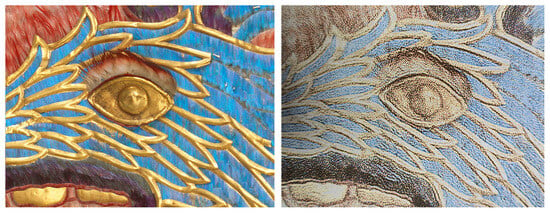
Figure 17.
Detail of original photo and screen print showing the pattern created by structure-aware halftoning.
6.5. Angle-Dependent Color in Reproductions
The reproductions of featherwork were examined under sunlight to determine if they display angle-dependent color, which is a key visual attribute of the original artifacts. Angle-dependent color implies that the perceived color of an object changes based on the viewing angle or incident light. Through visual analysis, it was found that the reproductions, indeed, exhibit angle-dependent color when they are viewed from different angles, especially when light is oblique, replicating the color variations observed in the original featherworks (Figure 18. Photographs taken from specific angles can be viewed in Appendix A).
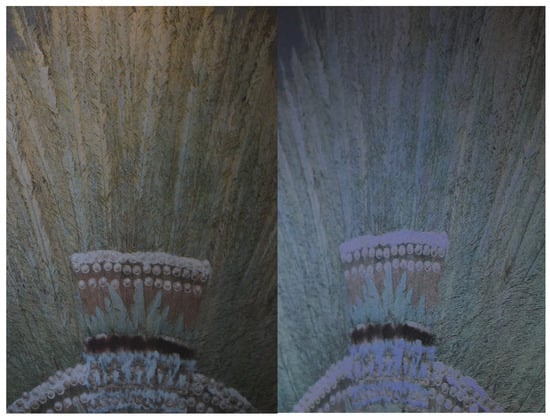
Figure 18.
Print of the headdress photographed from different angles.
While the prints demonstrate angle-dependent color (Figure A1, Figure A2, Figure A3 and Figure A4), it is not certain that this effect accurately represents what is often referred to as the iridescence observed in the original featherworks. Iridescence is a perceptual property resulting from the interaction of light with microscopic surface structures, resulting in a shimmering effect.
6.6. Micro-Photogtaphs
When observed under a microscope (20× magnification), the effect pigments appear to shine, as shown in Figure 19.

Figure 19.
Printed sections of effect pigments under a microscope.
The micro-photographs of Figure 19 were acquired using a Nikon Eclipse LV150N microscope, equipped with Nikon Optics 20x/0.45 and 5x/0.15 objectives. The microscope was coupled with a Digital Sight Camera, and image acquisition and processing were facilitated by the NIS Elements BR Software (V.4.30).
7. Discussion
Featherwork offers a unique opportunity not only to explore the historical use of feathers as colorants and their cultural significance but also to gain knowledge of new methods to reproduce the appearance of natural structures based on additive mixing principles.
While material science and nanotechnology present diverse approaches to opportunities to replicate microscopic surface structures, their practical application on a large scale is currently impractical. Virtual and augmented reality platforms hold the potential for creating immersive experiences that can simulate the dynamic appearance of featherwork, but their effectiveness relies on the availability of suitable display technologies.
Advanced printing technologies, such as multi-color 3D printing for reproducing goniocromatic effects in the mesoscopic regime [70], and, as shown in this work, 2D printing with specialized inks, are approaches to reproducing the color-shifting appearance of natural structures. The lustrous appearance of feathers, resulting from the interaction of light with microscopic surface structures, shares conceptual and perceptual similarities with the coloration achieved through light interference in multilayer reflectors, such as pearlescent pigments. Nevertheless, the reproduction of the appearance of featherwork through printing presents considerable challenges, particularly because the reference object is reproduced from a single view without the possibility of capturing the color gradations that define these artworks. Furthermore, reproducing the intangible qualities associated with cultural meaning and value adds another layer of complexity. An awareness of the materials used in featherwork can provide clues to approximate the appearance of the artwork when it is not physically accessible. Understanding the bird species used in featherwork and their reflective properties from multiple angles can offer valuable insights into its visual qualities [71].
With the information currently available, it is challenging to determine whether the angle-dependent color in the reproductions truly conveys an iridescent appearance. Further analyses, including a comparison with real feathers and expert opinions, are necessary to confirm that the change of color observed can be regarded as an iridescent effect in the reproductions. Characterizing structural coloration, on the other hand, would require a combination of techniques, including optical and electron microscopy-imaging methods, spectrally resolved photometric reflection, transmission, and absorption measurements [72]. In addition to angle-dependent color, the reproductions might convey depth and color fidelity. The structural colorants have effectively contributed to the visual appearance of depth, and the halftoning method contributed to achieving a more realistic texture. However, the limited gamut of RGB printing posed a challenge in accurately reproducing the full range of colors observed in the original artifacts.
Further research and development in these areas of additive printing and the characterization of the appearance produced by structural coloration mechanisms are crucial for improving the reproduction and preservation of featherwork and similar items. Understanding the material appearance of featherwork still calls for further scientific investigation in the future. The direct recording of the originals with angularly resolved photographic and spectral techniques might enable researchers to gain a deeper understanding of color mixing practices applied by featherwork artists in making the originals, which could lead to more accurate reproductions.
Author Contributions
Conceptualization, A.T.-V.; methodology, A.T.-V. and F.A.; software, A.T.-V., F.A. and C.P.; validation, A.T.-V. and F.A.; formal analysis, A.T.-V. and F.A.; investigation, A.T.-V., F.A., A.P. and C.P.; resources, C.P., S.K. and A.P.; data curation, A.T.-V.; writing—original draft preparation, A.T.-V.; writing—review and editing, A.T.-V., F.A., A.P., C.P. and S.K.; visualization, A.T.-V.; supervision, C.P. and S.K.; project administration, C.P.; funding acquisition, C.P. and S.K. All authors have read and agreed to the published version of the manuscript.
Funding
This research was funded with the support of an EPSRC grant EP/R011761/1, the ApPEARS Appearance Printing European Advanced Printing School European Union’s Horizon 2020 research and innovation program under the MSCA ITN-ETN grant agreement No. 814158, and Research England Expanding Excellence in England Fund 2019/22: Centre for Print Research. The project was supported by Merck by kindly donating the pigments. We would like to thank William Andre for helping with the printing.
Institutional Review Board Statement
Not applicable.
Informed Consent Statement
Not applicable.
Data Availability Statement
The data presented in this study are openly available in the UWE data repository [online]. Available from http://researchdata.uwe.ac.uk/713, accessed on 25 October 2023.
Acknowledgments
The project was supported by Merck by kindly donating the pigments. We would like to thank Donatela Saric from Fogra Research Institute for Media Technologies for taking the photographs of Appendix A.
Conflicts of Interest
The authors declare no conflict of interest.
Appendix A
The images shown in this appendix section were taken with a Canon EOS 700D camera, which was positioned at a fixed 45° angle to the samples. To maintain color accuracy, a reference white material (Barium Sulfate) was placed alongside each sample. The camera was calibrated to align the RGB values of barium sulfate with 255 255 255, ensuring accurate color representation in the images. Photos were taken with a D50 standardized illuminant. Lighting direction ranged from 0° to 55° in 15° increments. Tests at intermediate angles showed no significant differences in the results.
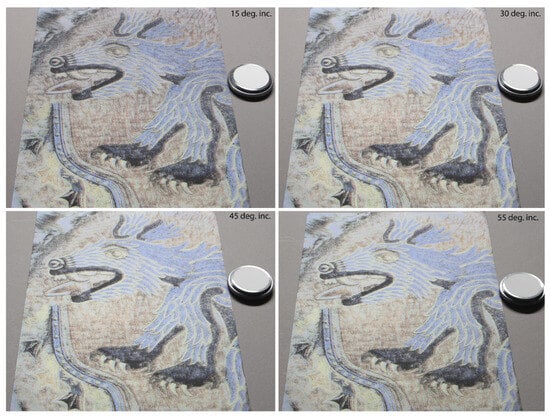
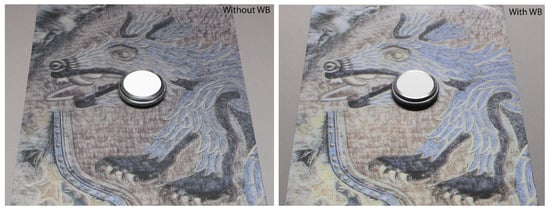
Figure A1.
From left to right and top to bottom: Print detail, photographed with the camera at 15°, 30°, 45°, 55° with respect to the normal direction, and 0° without white balance and with white balance.
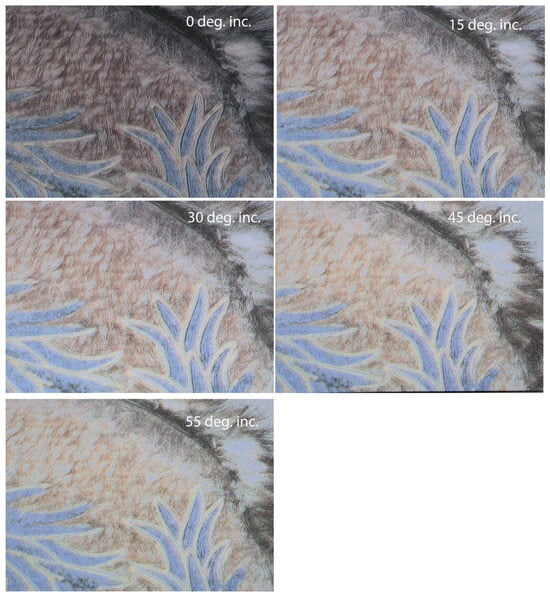
Figure A2.
From left to right and top to bottom: Print detail, photographed with the camera at 0°, 15°, 30°, 45°, and 55° with respect to the normal direction.
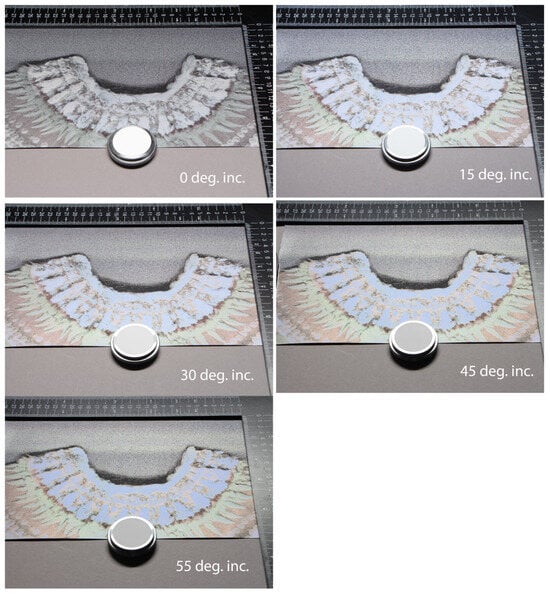
Figure A3.
From left to right and top to bottom: Print detail, photographed with the camera at 0°, 15°, 30°, 45°, and 55° with respect to the normal direction.
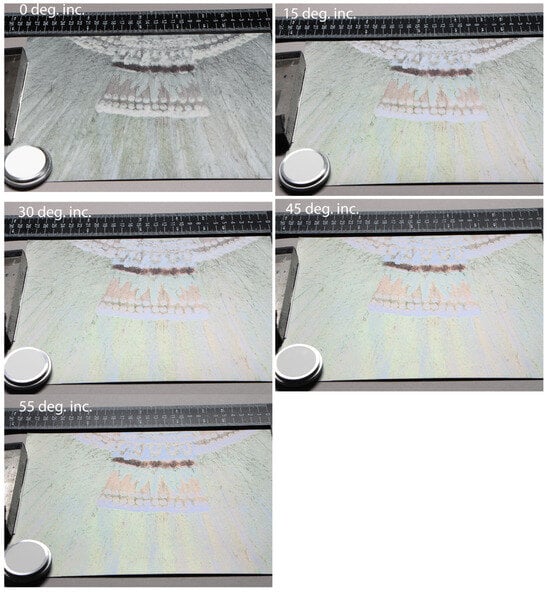
Figure A4.
From left to right and top to bottom: Print detail, photographed with the camera at 0°, 15°, 30°, 45°, and 55° with respect to the normal direction.
References
- Hilda, S. Splendor of Iridescence: Structural Colors in the Animal World, 1st ed.; Dodd, Mead & Company: New York, NY, USA, 1971. [Google Scholar]
- Finet, C. Light as matter: Natural structural colour in art. Humanit. Soc. Sci. Commun. 2023, 10, 348. [Google Scholar] [CrossRef]
- Britannica, T. Editors of Encyclopaedia. “Featherwork.” Encyclopedia Britannica. 24 February 2016. Available online: https://www.britannica.com/art/featherwork (accessed on 23 July 2023).
- Milburn, O. Featherwork in early and Medieval China. J. Am. Orient. Soc. 2020, 140, 549–564. [Google Scholar] [CrossRef]
- King, H. Peruvian Featherworks: Art of the Precolumbian Era; Metropolitan Museum of Art: New York, NY, USA, 2012. [Google Scholar]
- Di Lorenzo, S.; Manuale, S.E. Documentando y conservando las colecciones plumarias del Museo Etnográfico Juan B. Ambrosetti. In PreColumbian Textile Conference VIII; Bjerregaard, L., Peters, A., Eds.; Zea Books: Lincoln, NE, USA, 2022; pp. 311–325. [Google Scholar]
- Teresa, C.Y.; Manuel, C.P. El Arte Plumaria en México, 1st ed.; Fomento Cultural Banamex, AC: Mexico City, Mexico, 1993. [Google Scholar]
- Riedler, R.; Pearlstein, E.; Gleeson, M. Featherwork: Beyond decorative. Stud. Conserv. 2012, 57 (Suppl. S1), S244–S249. [Google Scholar] [CrossRef]
- Moreno Guzmán, M.O.; Korn, M.R. El penacho de Moctezuma. Arqueol. Mex. 2019, 159, 62–66. [Google Scholar]
- Olsen, J. The Art of Amanteca: Or Feather Craftspeople. Voices Mex. 1998, 42, 77–82. [Google Scholar]
- Dittborn, P. Instrucciones para armar: Imágenes de la Plumaria Novohispana en el códice Florentino. Revista 180 2017, 40, 30–41. [Google Scholar] [CrossRef]
- Arroyo Urióstegui, A.J.; Rentería, I.P. Arte plumaria novohispano. Una reflexión plástica. Diseño y Soc. 2009, 77, 40–43. [Google Scholar]
- Magaloni-Kerpel, D. Real and Illusory Feathers: Pigments, Painting Techniques, and the Use of Color in Ancient Mesoamerica. Nuevo Mundo Mundos Nuevos [Enligne]. 2006. Available online: http://journals.openedition.org/nuevomundo/1462 (accessed on 23 July 2023).
- Sahagún, B.D. General History of the Things of New Spain by Fray Bernardino de Sahagún: The Florentine Codex; Book IX: The Merchants. 1577. Pdf. Retrieved from the Library of Congress. Available online: https://www.loc.gov/item/2021667854 (accessed on 24 July 2023).
- Wikimedia Commons Contributors. “File:Resplendent Quetzal—Panama H8O1573 (16305973361).jpg”. Wikimedia Commons. Available online: https://commons.wikimedia.org/w/index.php?title=File:Resplendent_Quetzal_-_Panama_H8O1573_(16305973361).jpg&oldid=752080965 (accessed on 23 October 2023).
- Elena Phipps, T. Clothing the New World Church: Liturgical textiles of Spanish America, 1520–1820. Colon. Lat. Am. Rev. 2022, 31, 164–166. [Google Scholar] [CrossRef]
- Russo, A. Lugares INAH: Museo Nacional del Virreinato. Available online: https://lugares.inah.gob.mx/en/museos-inah/museo/museo-piezas/1567-1567-10-28966-salvator-mundi.html (accessed on 23 July 2023).
- Russo, A. Plumes of Sacrifice: Transformations in Sixteenth-Century Mexican Feather Art. RES Anthropol. Aesthet. 2002, 42, 226–250. [Google Scholar] [CrossRef]
- McMahon, B.C. Contingent Images: Looking Obliquely at Colonial Mexican Featherwork in Early Modern Europe. Art Bull. 2021, 103, 24–49. [Google Scholar] [CrossRef]
- Caplan, A.N. Their Flickering Creations: Value, Appearance, Animacy, and Surface in Nahua Precious Art. Ph.D. Thesis, Tulane University, New Orleans, LA, USA, 2019. [Google Scholar]
- Salvator Mundi. Mediateca INAH. Available online: https://lugares.inah.gob.mx/es/museos-inah/museo/museo-piezas/1567-1567-10-28966-salvator-mundi.html?lugar_id=475 (accessed on 23 October 2023).
- Coutau-Bégarie. Tableau en Plumes Polychromes sur Panneau... - Lot 159. Coutau-Bégarie. Available online: https://www.coutaubegarie.com/lot/96259/10296899 (accessed on 23 October 2023).
- McMahon, B.C. Iridescence, Vision, and Belief in the Early Modern Hispanic World. Ph.D. Thesis, University of Southern California, Los Angeles, CA, USA, 2017. [Google Scholar]
- Meadows, M.G. Iridescence: Views from many angles. J. R. Soc. Interface 2009, 6, S107–S113. [Google Scholar] [CrossRef] [PubMed]
- Burkhardt, D. UV vision: A bird’s eye view of feathers. J. Comp. Physiol. 1989, 164, 787–796. [Google Scholar] [CrossRef]
- Kinoshita, S.; Yoshioka, S. Structural Colors in Nature: The Role of Regularity and Irregularity in the Structure. Chem. Phys. Chem. 2005, 6, 1442–1459. [Google Scholar] [CrossRef]
- Structural Colour: More than Meets the Eye: How Microscopic Structures Create Nature’s Most Dazzling Colours. Olorunshola, Yosola. Available online: https://www.kew.org/read-and-watch/structural-colour-more-than-meets-the-eye (accessed on 25 July 2023).
- Leech, D. Bioinspiration in Printmaking—Routes Toward Structural and Pigmentless Colour. IMPACT Printmak. J. 2020, 2, 14. [Google Scholar] [CrossRef]
- Fascinating Displays of Colour: Effect Pigments—A Successful Interplay of Chemistry and Physics. Prof. Dr. Gerhard Pfaff (Merck KGaA, Merck KGaA). Available online: https://q-more.chemeurope.com/q-more-articles/190/fascinating-displays-of-colour.html (accessed on 25 July 2023).
- Pfaff, G. Special Effect Pigments: Technical Basics and Applications, 2nd ed.; Vincentz Network GmbH & Co., KG: Hannover, Germany, 2008. [Google Scholar]
- Schenk, F.; Wilts, B.D.; Stavenga, D.G. The Japanese jewel beetle: A painter’s challenge. Bioinspir. Biomim. 2013, 8, 045002. [Google Scholar] [CrossRef] [PubMed]
- Schenk, F.; Parker, A. Iridescent Color: From Nature to the Painter’s Palette. Leonardo 2011, 44, 108–115. [Google Scholar] [CrossRef]
- Abedini, F.; Gooran, S. Structure-Aware Color Halftoning with Adaptive Sharpness Control. J. Imaging Sci. Technol. 2022, 66, 060405-1. [Google Scholar] [CrossRef]
- Abedini, F.; Trujillo-Vazquez, A.; Gooran, S.; Klein, S. Effect of halftones on printing iridescent colors. In Proceedings of the IS&T Electronic Imaging, San Francisco, CA, USA, 16–19 January 2023; Society for Imaging Science and Technology: Springfield, IL, USA, 2023; Volume 35, pp. 1–6. [Google Scholar]
- Daher, C.; Tournié, A.; Sauvagnargues, F.; Andraud, C.; Cuisin, J.; Illes, V.; Kissel, É. Colored feathers in museum collections: A spectroscopic study of 3 bio-pigments and their lightfastness. J. Cult. Herit. 2020, 45, 59–70. [Google Scholar] [CrossRef]
- Doucet, S.M.; Hill, G.E. Do museum specimens accurately represent wild birds? A case study of carotenoid, melanin, and structural colours in long-tailed manakins Chiroxiphia linearis. J. Avian Biol. 2009, 40, 146–156. [Google Scholar] [CrossRef]
- Riedler, R.; Pesme, C.; Druzik, J.; Gleeson, M.; Pearlstein, E. A review of color-producing mechanisms in feathers and their influence on preventive conservation strategies. J. Am. Inst. Conserv. 2014, 53, 44–65. [Google Scholar] [CrossRef]
- Lundin, P.; Samuelsson, P.; Svanberg, S.; Runemark, A.; Åkesson, S.; Brydegaard, M. Remote nocturnal bird classification by spectroscopy in extended wavelength ranges. Appl. Opt. 2011, 50, 3396–3411. [Google Scholar] [CrossRef] [PubMed]
- Dyck, J. Reflectance Spectra of Plumage Areas Colored by Green Feather Pigments. Auk 1992, 109, 293–301. [Google Scholar] [CrossRef]
- Noh, H.; Liew, S.F.; Saranathan, V.; Mochrie, S.G.; Prum, R.O.; Dufresne, E.R.; Cao, H. How noniridescent colors are generated by quasi-ordered structures of bird feathers. Adv. Mater. 2010, 22, 871–880. [Google Scholar] [CrossRef] [PubMed]
- LaBastille, A.; Allen, D.G.; Durrell, L.W. Behavior and Feather Structure of the Quetzal. Auk 1972, 89, 339–348. [Google Scholar]
- Norden, K.K.; Faber, J.W.; Babarović, F.; Stubbs, T.L.; Selly, T.; Schiffbauer, J.D.; Peharec Štefanić, P.; Mayr, G.; Smithwick, F.M.; Vinther, J. Melanosome Diversity and Convergence in the Evolution of Iridescent Avian Feathers—Implications for Paleocolor Reconstruction. Evolution 2019, 73, 15–27. [Google Scholar] [CrossRef] [PubMed]
- Prum, R.O. Anatomy, physics, and evolution of structural colors. In Bird Coloration, Volume 1: Mechanisms and Measurements; Hill, G.E., McGaw, K.J., Eds.; Harvard University Press: Cambridge, MA, USA, 2006; pp. 295–353. [Google Scholar]
- Lewis, P.A. Chapter 10—Colorants: Organic and Inorganic Pigments. In Color for Science, Art and Technology; Nassau, K., Ed.; Elsevier Science B.V.: Amsterdam, NL, USA, 1998; pp. 283–312. [Google Scholar]
- Maile, F.J.; Pfaff, G.; Reynders, P. Effect pigments—Past, present and future. Prog. Org. Coat. 2005, 54, 150–163. [Google Scholar] [CrossRef]
- Karlovits, M. Characterization of Angle Dependent Color Travel of Printed Multi-Color Effect Pigment on Different Color Substrates. Acta Graph. 2014, 25, 57–60. [Google Scholar]
- Parraman, C.; Klein, S. Printing the light. Color. Technol. 2021, 137, 86–89. [Google Scholar] [CrossRef]
- Pearlescent Pigments—How They Work. George O’Hanlon. Available online: https://www.naturalpigments.com/artist-materials/pearlescent-pigments-how-they-work (accessed on 25 July 2023).
- Trujillo-Vazquez, A.; Fuller, H.; Klein, S.; Parraman, C. The Amber Project: A Survey of Methods and Inks for the Reproduction of the Color of Translucent Objects. Appl. Sci. 2022, 12, 793. [Google Scholar] [CrossRef]
- Pranovich, A.; Vazquez, A.T.; Nyström, D.; Valyukh, S.; Frisvad, J.R.; Klein, S.; Parraman, C. Angular dependent reflectance spectroscopy of RGBW pigments. Adv. Print. Media Technol. 2023. [Google Scholar] [CrossRef]
- Noor, A.I.; Mokhtar, M.H.; Rafiqul, Z.K.; Pramod, K.M. Understanding Color Models: A Review. ARPN J. Sci. Technol. 2012, 2, 265–275. [Google Scholar]
- Simonot, L.; Hébert, M. Between additive and subtractive color mixings: Intermediate mixing models. J. Opt. Soc. Am. 2013, 31, 58–66. [Google Scholar] [CrossRef] [PubMed]
- Meruga, J.M.; Baride, A.; Cross, W.; Kellar, J.J.; May, P.S. Red-green-blue printing using luminescence-upconversion inks. J. Mater. Chem. C 2014, 2, 2221–2227. [Google Scholar] [CrossRef]
- Guzmán, M.O.M.; Korn, M.R. Investigación y Conservación Bajo Presión; Publicaciones Digitales ENCRyM: Ciudad de México, Mexico, 2014. [Google Scholar]
- Aztecs at Mexicolore. Vienna’s Mesoamerican Featherworks. Available online: https://www.mexicolore.co.uk/aztecs/home/viennas-mesoamerican-featherworks (accessed on 24 July 2023).
- Ahuizotl (Mythology). Wikipedia Contributors. Wikipedia, The Free Encyclopedia, 10 May 2023.
- Sejourne, L. Burning Water: Thought and Religion in Ancient Mexico, 1st ed.; Thames & Hudson: London, UK, 1978. [Google Scholar]
- Baumgartner, W. The Aztec Feather Shield in Vienna: Problems of Conservation. Nuevo Mundo Mundos Nuevos [En ligne], Colloques, mis en ligne. Available online: https://journals.openedition.org/nuevomundo/1447 (accessed on 30 June 2023).
- Sharma, G.; Bala, R. Digital Color Imaging Handbook, 1st ed.; CRC Press: Boca Raton, FL, USA, 2017. [Google Scholar]
- The Print Guide. Pritchard, Gordon. Available online: http://the-print-guide.blogspot.com/2009/05/halftone-screen-angles.html (accessed on 28 July 2023).
- Falk, D.S.; Brill, D.R.; Stork, D.G.; Ruiz, M.J. Seeing the Light: Optics in Nature, Photography, Color Vision and Holography; John Wiley and Sons: Hoboken, NJ, USA, 1988; p. 256. [Google Scholar]
- Gooran, S.; Kruse, B. High-speed first- and second-order frequency modulated halftoning. J. Electron. Imaging 2015, 24, 023016. [Google Scholar] [CrossRef]
- Flick, B.; Graboswki, B. Printmaking Second Edition: A Complete Guide to Materials & Processes Paperback—Illustrated, 2nd ed.; Laurence King Publishing: London, UK, 2015. [Google Scholar]
- Print Club London. Screenprinting: The Ultimate Studio Guide from Sketchbook to Squeegee; Princeton Architectural Press: New York, NY, USA, 2018. [Google Scholar]
- Parraman, C. Black to Black. In Printmaking Today Winter; Cello Press Ltd.: Oxford, UK, 2018; pp. 32–33. [Google Scholar]
- Süsstrunk, S.; Buckley, R.; Swen, S. Standard RGB color spaces. In Proceedings of the IS&T/SID 7th Color Imaging Conference, Scottsdale, AZ, USA, 16–19 November 1999; pp. 127–134. [Google Scholar]
- Headquarters, C. A Adobe® RGB (1998) Color Image Encoding. 2005. Available online: http://www.audentia-gestion.fr/ADOBE/AdobeRGB1998.pdf (accessed on 26 July 2023).
- A Guide to Understanding Graphic Arts Densitometry. X-Rite. Available online: https://www.xritephoto.com/documents/literature/en/L7-093 (accessed on 26 July 2023).
- Murray, A. Monochrome reproduction in photoengraving. J. Frankl. Inst. 1936, 221, 721–744. [Google Scholar] [CrossRef]
- Abu Rmaileh, L.; Brunton, A. Meso-Facets for Goniochromatic 3D Printing. ACM Trans. Graph. 2023, 42, 66. [Google Scholar] [CrossRef]
- Meadows, M.G.; Morehouse, N.I.; Rutowski, R.L.; Douglas, J.M.; McGraw, K.J. Quantifying iridescent coloration in animals: A method for improving repeatability. Behav. Ecol. Sociobiol. 2011, 65, 1317–1327. [Google Scholar] [CrossRef]
- Vukusic, P.; Stavenga, D.G. Physical methods for investigating structural colours in biological systems. J. R. Soc. Interface 2009, 23, S133–S148. [Google Scholar] [CrossRef]
Disclaimer/Publisher’s Note: The statements, opinions and data contained in all publications are solely those of the individual author(s) and contributor(s) and not of MDPI and/or the editor(s). MDPI and/or the editor(s) disclaim responsibility for any injury to people or property resulting from any ideas, methods, instructions or products referred to in the content. |
© 2023 by the authors. Licensee MDPI, Basel, Switzerland. This article is an open access article distributed under the terms and conditions of the Creative Commons Attribution (CC BY) license (https://creativecommons.org/licenses/by/4.0/).